
The Basics:
- For ages 9 and up (publisher suggests 10+)
- For 2 players
- Approximately 45 minutes to complete
Geek Skills:
- Active Listening & Communication
- Counting & Math
- Logical & Critical Decision Making
- Reading
- Memorization & Pattern/Color Matching
- Strategy & Tactics
- Risk vs. Reward
- Hand/Resource Management
- Bluffing and Misdirection
Learning Curve:
- Child – Moderate
- Adult – Easy
Theme & Narrative:
- Dominate the City through your vampiric Will or liberate its people by slaying the undead!
Endorsements:
- Gamer Geek approved!
- Parent Geek mixed!
- Child Geek mixed!
Overview
It began with the disappearance of a child. Some blamed wolves while others suggested the child just wandered off. But you know better. The city is full of secret places and dark alcoves where evil waits to pounce on the innocent. The old castle that overlooks the city might hold friends who can help you or the very fiends you are attempting to kill. You must be smart to survive and the prey you hunt have survived for hundreds of years.
Vampire Empire, designed by Filip Miłuński and published by Stronghold Games, is comprised of 40 Vampire cards, 40 Human cards, 12 Attack/Defense markers,9 Character cards (double-sided), 9 cards sleeves, 9 Character tokens, and 1 cloth bag. Also included is a handy card overview sheet for quick reference. Despite the game being about vampires and the undead, the illustrations on the cards are very tame. None of our Parent Geeks had any problems with the card artwork.
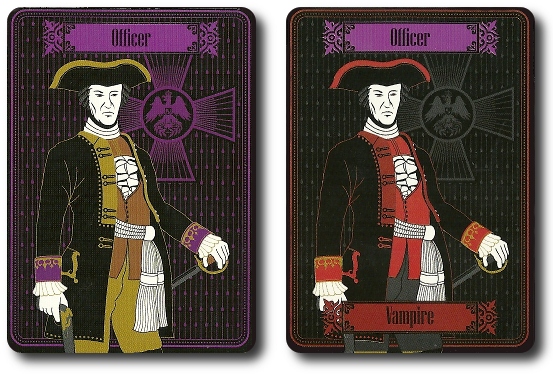
As the above illustration shows, the difference between the human officer and the vampire officer is really nothing more than a subtle change in attire and a penchant for the color red. Which, if taken to mean that any Character who wears red is a vampire, the First Lady of the United States Barbara Bush should be very carefully watched…

I’m onto you, Barbara!
Game Set Up
To set up the game, first separate the cards into three different piles. When completed, there will be a Vampire pile (moon image on the card back), a Human pile (sun image on the card back), and a Character pile. Take the 9 Character cards and place them in the card sleeves. Make sure the human side is showing. Once completed, shuffle the Character cards and place them face-down in the middle of the playing area. This pile of cards is referred to as “the City” deck. From the City deck, draw 3 Character cards and place them, face-up, in a row next to the City deck. This row is referred to as the “Castle”.
Second, decide who will play as the Vampire and who will play as the Human. Give each player their specific deck of cards. Each player should shuffle their deck, deal themselves 8 cards, and then place the deck to their immediate right. This is the player’s draw deck for the remainder of the game. The players should look at their cards but keep them hidden from their opponents at all times.
Third, the Vampire player should now take the 9 Character tokens, place them in the cloth bag, and then randomly draw 3. These 3 Character tokens identify which 3 Character cards are vampires, but this is only known to the Vampire player at this time. The Vampire player will place these 3 Character tokens, face-down, in front of them.
Fourth, the Human player now randomly draws 2 Character tokens. These 2 Character tokens identify 2 Character cards that are humans. The Human player will place these 2 Character tokens, face-down, in front of them. The remaining Character tokens are left in the bag and set to one side of the game playing area.
Fifth, the Attack/Defense markers are placed to one side of the game playing area and within each reach of all the players.
This concludes the game set up. The Vampire player will go first. Time to hunt!
Card Basics
Vampire Empire gives each player their own unique deck. Each deck is comprised of 3 different card types. They are summarized here.
Combat Cards
The Combat cards are used by both players if combat is taken as an action. Every Combat card shows up to 3 different colors (representing the influential nobles, servants, and clergy of the city). These are considered “professions” and can only be used in combat if the Character card being used matches the profession on the Combat card. Note that some Combat cards also include vampire (red), which means it can be attached to any noble, servant, or clergy if the Character is a revealed vampire. The combat value is used during combat to determine which Character, the attacker or the defender, wins the battle.
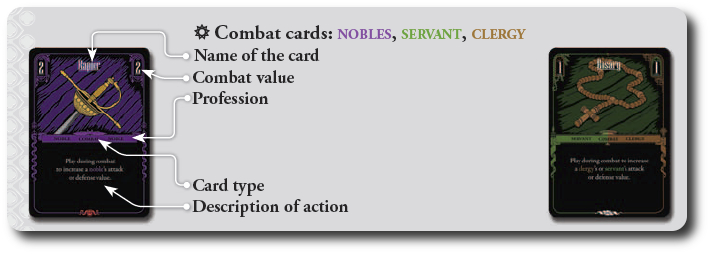
Vampire Cards
Vampire cards are only found in the Vampire player’s deck. These cards represent specific vampire abilities. Like Combat cards, they have a combat value that is used during combat. While powerful, they can only be used on Character cards that are revealed vampires.

Holy Water Cards
Holy Water cards are only found in the Human player’s deck. These cards represent specific tools the vampire hunter would have on their person. Like Combat cards, they have a combat value that is used during combat.
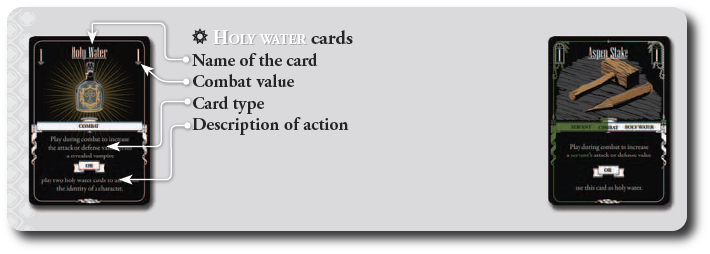
Support Cards
Support cards are found in both player’s decks and provide special actions and bonuses, but at a cost. Players can play Support cards out of turn anytime after step 2, before step 3, and after step 3 (not during step 3). There are a few Support cards that specifically need to be used during combat, which breaks the normal rule of when Support cards can be played.
On each Support card is an icon that represents the day (sun) and the night (moon). When it’s the Vampire player’s turn, it’s the night and when it’s the Human player’s turn, it’s the day. The number next to the icons identifies the cost of the card depending on when it’s played. Players pay for the Support card by discarding a number of cards from their hand equal to the cost of the Support card. The discarded cards go to the player’s Moat.
Some Support cards provide a bonus to a Character’s Attack and Defense Value during combat. These are kept track of by using the Attack/Defense markers. The markers stay on the Character card for as long as they remain in the Castle. Once they hide, are slain, or sent to the City, the markers are removed. The modifiers only apply to the first round of combat. During the second round, any bonuses provided by the markers are simply ignored but remain on the Character if they survive.
A Support card might allow a player to choose a card from their Moat, Cellar, or draw deck. When allowed, the player takes all the cards from the specified pile and looks through them to find the card they want. Once the card is taken, the pile is shuffled and placed face-down in its original location. This is the only time a player can retrieve an otherwise lost card sent to their Moat.
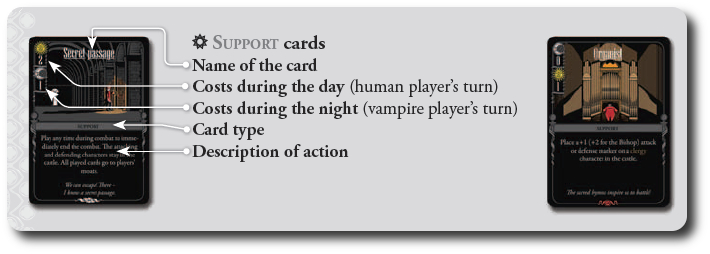
Of Fangs and Stakes
Vampire Empire is played in turns with no set number of turns per game. While each player has a different goal, each shares a common number of sequential steps they must complete on their turn. A player’s turn is summarized here. When it’s a player’s turn, they are referred to as the “active player”.
Step 1: Discard and Draw Cards
The active player can discard any number of cards from their hand and draw new cards up to 8 in total. This step is not optional. Players cannot play a Support card at this time.
The player has 2 discard piles. The discard pile immediately next to their draw deck is referred to as “the Cellar”. Any cards placed in the Cellar will be returned to the player later in the game, but are currently unavailable until they return to the player’s draw deck. The discard pile opposite of the draw deck and the Cellar is referred to as “the Moat”. Any cards placed in the Moat are out for the duration of the game.
Therefore, a player must decide where they want to place a card when they discard it. As the game progresses, there will be cards that no longer make sense to keep, but might be useful later in the game. This step is the only time a player can decide where unneeded cards will be placed. A choice some players might find difficult to make. Regardless of which discard pile the player uses, cards are always discarded face-down.
After the player discards any cards they like, they draw new cards from their draw deck to have a complete hand of 8 cards. A player cannot have anymore than 8 cards in their hand before they continue on to the next step. Some Support cards will give players more than 8 cards. If they have more than 8 when it’s their turn during this step, they must discard down to at most 8 cards and less if they want draw new cards.
Note that if a player’s draw deck is ever exhausted, they take whatever cards are in their Cellar, shuffle them, and use those cards as their new draw deck. Once the Cellar is used to create a new draw deck, any cards played or discarded must ALWAYS go to the player’s Moat.
Step 2: Reveal a Vampire’s Identity
This step is only taken by the Vampire player and skipped by the Human player. This step is optional.
The Vampire player can now reveal one of their 3 Character tokens by placing it face-up in front of them if they like. This Character is now a known vampire! If the Character card is currently visible in the Castle, take the card and flip it in the sleeve so the vampire side is showing. The card is then placed back in the Castle. If the revealed vampire is hiding in the City, the Character card will not be flipped until it enters the Castle. Regardless, the Human player now knows who to hunt!
Revealing a Character as a vampire might seem counterproductive when you are a Vampire player attempting to hide and survive. However, when a Character card is revealed to be a vampire, the Vampire player has many more options available to them. In this way, a Vampire player gains a great deal more choice and tactics, but at the cost of revealing a Character as a vampire which the Human player will now attempt to destroy.
After Vampire player decides to reveal or not to reveal a Character’s true identity, both players can play a Support card at this time if they like.
Step 3: Perform One Action
The active player has 3 actions to choose from. This step is not optional. Note that Support cards cannot be played during this step unless the Support card is specific to combat.
Hide a Character
The Vampire player can decide to place one of the Character cards in the Castle and hide them in the City. The Character they decide to hide need not be a revealed vampire. Indeed, the Character might be a human, but the intent of this action is to not only protect revealed vampires but to also possibly mislead the Human player.
To hide any Character card, the Vampire player must play 3 Combat cards from their hand and place them in the Moat. The player can then take the Character card of their choice and place it at the bottom of the City. The top card on the City is then drawn and placed in the Castle. Any Attack/Defense markers on the Character card moved to the City are removed.
Use Holy Water
The Human player can decide to attempt to determine a Character’s identity. Any Character can be interrogated. The Character card the Human player is interested in need not be visible in the Castle.
To determine a Character’s true identity, the Human player must play 2 Holy Water cards from their hand and place them in the Moat. The Human player then points to one of the 3 Character cards in the Castle or names the Character card currently in the City. The Vampire player must truthfully tell the Human player if their selected Character is a vampire or not.
If the selected Character is a vampire, the Vampire player turns the matching Character token face-up in front of them. This Character is now a known vampire! If the Character card is currently visible in the Castle, take the card and flip it in the sleeve so the vampire side is showing. The card is then placed back in the Castle. If the revealed vampire is hiding in the City, the Character card will not be flipped until it enters the Castle.
If the Human player successfully revealed a Character as a vampire currently located in the Castle, they are awarded an opportunity to sneak attack them by taking the Combat action. This is the only time a player can take 2 actions during this step. The lower valued Holy Water card is used, plus any additional cards from the player’s hand during the first round of combat.
If the Human player reveals that the Character is not a vampire, there is no way to mark them as such. The Human player will have to remember who they interrogated in hopes of not repeating the same action during a future turn. In this way, a Human player must remember who they have interrogated, which will help them deduce who the vampires are.
Combat
Combat is the only way to remove a Character card from the game. The Human player will want to attack and remove revealed vampires, but they might also want to attack a Character who they “think” is a vampire. A Human player can attack any Character, regardless if they are known vampire or not. The Vampire player will want to attack Characters, too. By removing Characters, the Vampire player removes possible threats and can mislead the Human player.
Combat is very straightforward and involves nothing more than simple math. Combat is completed in 2 rounds and follows a sequential order.
- Choose a Character: Only characters in the Castle can be used during combat. The Human player, if active, can select any Character that is not a revealed vampire to attack with. The Vampire player, if active, must select any Character in the castle that is a revealed vampire to attack with. If none are present, the Vampire player can select any Character in the castle as long as that Character isn’t a revealed human (based on the Character tokens). The active player then selects 1 of the 2 remaining Characters in the Castle who will be the target of the attack.
- Combat Ensues: The active player now plays 1 or 2 Combat cards from their hand for the attacking Character. In response, the non-active player now plays 1 or 2 Combat cards from their hand for the defending Character. The total sum of the Combat cards for the attack is referred to as the “Attack Value” and the total sum of the Combat cards for the defender is referred to as the “Defense Value”.
- Determine Winner: If the Attack Value is GREATER THAN the Defense Value, the attacking Character wins and the defending Character is removed from the game. If the removed Character was a vampire, the Vampire player now flips over the matching Character token. A new Character is immediately drawn from the City and placed in the Castle. This ends the combat action. However, if the Defense Value is EQUAL TO OR GREATER THAN the Attack Value during the first round of combat, a second round of combat ensues. The cards played during the last round are added to any new cards played in the second round. The Attack and Defense Values are then summed and compared.
The active player can only ever attack using 1 Character and can only attack 1 target Character. If the target Character survives both rounds of combat, it simply remains in the Castle. Any removed Characters who have been beaten during combat are placed to one side of the game playing area. Any player can review which Characters have been removed during the game. All played cards are placed in the player’s Moat.
Note that a player cannot initiate an attack against a Character if they cannot play enough cards to beat the target Character’s Defense Value. Through Support cards, a player can apply Defense Value bonuses. If the target Character has more Defense Value than the player can possibly beat, that Character cannot be attacked. A Human player would be wise to watch the Vampire player very carefully when they start to add Defense Value bonuses to a Character that would appear to be a human. The Vampire player might be building up the defenses of a yet to be revealed vampire or simply tricking the Human player.
Pass
Finally, a player can decide to simply pass and not take any action, but at the cost of discarding 2 cards from their hand and placing them in the Moat.
Step 4: End Turn
This completes the player’s turn. Unless the game has been won, the next player now goes starting with step 1 above. Players can play a Support card at this time if they like, but must do so before the next player takes their turn.
Eternal Night or Blessed Day
The game can ends several different ways.
- All human Characters die, in which case, the Vampire player wins.
- All vampire Characters die, in which case, the Human player wins.
- If all 3 Characters in the Castle are revealed vampires, the Vampire player wins.
- If both players run out of cards in their hand and their draw deck (remember, you only get to refresh your draw deck once with the Cellar), the Human player gets 1 point for every surviving human and the Vampire players gets 2 points for every surviving vampire. The player with the most points wins.
If only one player runs out of cards during the game, the other player continues to take their turn as normal until one of the above conditions are met.
To learn more about Vampire Empire, visit the game’s web page.
Prediction
Two-player games tend to be well received and difficult to review with my groups. Vampire Empire is as much about hand management and solid card plays as it is about deduction. Those are skills that can only be strengthened through time and practice. Child Geeks are going to be outmatched and outgunned if they play against a Parent Geek, which will lead to hurt feelings. I predict that the game will frustrate the Child Geeks which might lead them to reject it. I think, at best, we can hope for a mixed approval rating from the Child Geeks. That goes for the Parent Geeks, too. I don’t know if they would fully get behind a 2-player game that automatically was perceived to be imbalanced and gave the clear advantage to the stronger player. With their peers, Vampire Empire should do very well, but with their Child Geeks, I doubt we’ll see much love. Like the Child Geeks, I’m going to guess we’ll see a mixed level of approval from the Parent Geeks.
For the Gamer Geeks, this game should do very well. The game is subtle, requires a great deal of foresight, and strong hand management with a critical eye for strategy. The game is full of tactics, which are represented by the cards, but what is really going to challenge the Gamer Geeks (and all our players) is knowing when to keep a card and get rid of a card. If a player gets rid of a card too soon, they will suffer for it. The Vampire player knows more going into the game, but has limited power until they reveal their vampires to the Human player. The Human player, as a result, has a weaker position in the game at first, but can gain a strong advantage through deduction and by simply being patient. I’m certain this type of game play will appeal to the Gamer Geeks resulting in a strong level of approval.
Teaching Vampire Empire is a bit tricky. I suggest you focus on the steps each of the players take on their turn, ensure the players understand how cards are used and lost, and check to make certain both players know how they win. After that, it’s really all about what cards the player has in their hand, what they want to do, and what they “think they know” about their opponent. You can’t teach that and this is where it’s very important to be as helpful as possible when teaching the game. If you can manage it, I highly recommend that the person teaching the game be an independent 3rd party that either of the two players can tap to answer questions.
Make no mistake, Vampire Empire is a very straight forward game with light rules. It is, therefore, an easy learning curve for just about any player. However, a player cannot really learn how to play the game until they are given their cards and asked to make choices. For the Child Geeks, this will make an otherwise easy game to teach into a moderately difficult game to grasp. For the Parent and Gamer Geeks, I see no reason why they won’t be able to learn the game very quickly and easily, but I doubt they’ll truly understand the game completely until they have at least 1 game completed.
When playing Vampire Empire for the first time with new players, regardless if they are experienced or not, I suggest you let them play as the vampire. The vampire is a bit easier to play and has better odds of winning the game. The Human player tends to be a lot more guess-work and exploration which can only truly be done right if the player has the right cards and knows how to use them. Therefore, the Human player should be the more experienced of the two. While the game play between the two different players will be similar in many ways, the strategy and tactics are very different. Luckily, after the player learns the game, they can switch sides without issue thanks to both players have similar actions and steps they take on their turn.
It should also be obvious at this point that the game requires the player to be able to read. Any younger Child Geek who cannot yet read well will not be able to play Vampire Empire. For those younger Child Geeks who were still interested in the game, we teamed them up with an older player. This served as an excellent exercise in teamwork and memorization for the younger Child Geeks, despite the fact they could not read the cards.
After teaching the game to my Child Geek, I asked him his thoughts on Vampire Empire so far.
“This game sounds really cool! I love that you have to be sneaky and you can also fight each other. Awesome sounding game!” ~ Liam (age 9)
He does make it sound awesome. Let’s see if my little geek’s initial impressions are correct.
Final Word
This was a very difficult game to play with the Child Geeks, not because the game itself is difficult, but because the Child Geeks became either bored or frustrated fairly quickly. Vampire Empire is not a quick game, nor is it one that will get your heart racing. The game is very subtle and subtly, my friends, is not something a Child Geek appreciates. The older and more patient Child Geeks kept with it, however, and they began to enjoy the game more as a result. My oldest Child Geek was one of the few that kept giving the game a try and it paid off. His first impressions about the game were not great. “Boring” and “slow” were two terms used to describe the game by many of our Child Geek players. But the more you play the game, the more of the game’s – again – subtle play emerges. According to one Child Geek, “I didn’t understand this game until just now, which is funny, because I’ve played it 3 times already.” When it came time to vote for the game, those Child Geeks who only wanted to play it 1 or 2 times gave it either an “OK” or “No” vote, while the Child Geeks who played it at least 3 times, all voted to approve it. The end result was a mixed bag from the Child Geeks.
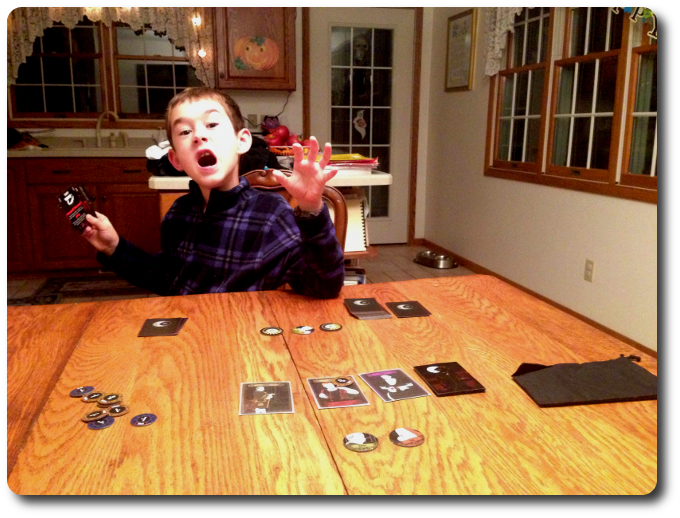
My little geek vampire shows me his fangs (and outrageously expensive braces) as he prepares to attack!
The Parent Geeks immediately recognized that there was more to the game than what they experienced after their first play, but that was not enough to tantalize a number of the Parent Geeks to explore it further. According to one Parent Geek, “The game leaves me with a nagging feeling that I missed something, but if I don’t like the game after the first play, I don’t see any reason to play it again.” Many of our Parent Geeks agreed and politely declined to play the game further after playing it once or twice. There were a few Parent Geeks who kept at it, however, either because they were interested in learning more or their Child Geeks wanted to play the game with them. For those who did, they became more interested and excited about the game after every play. According to one Parent Geek, “I feel sorry for the others who didn’t give this game a chance. It’s awesome.” When it came time to vote, the results were mixed and identical to the Child Geeks. For those who played the game only a few times, the endorsements were not positive, but for those who kept playing the game, they gave it their full approval.
The Gamer Geeks really enjoyed Vampire Empire, but not at first. It took several games before they started to really appreciate the game’s depth and strategy. It should be noted that the game caught their attention and held it from the very start, but a single game was never enough for any of our Gamer Geeks to say they really liked it. According to one Gamer Geek, “After my first game, I was like, really? Is that it? It took a few more games until I realized this was a game I really enjoyed.” All the Gamer Geeks agreed and thought it was one of the better 2-player deduction games they had played in a long time. But according to one Gamer Geek, “This game is less about determining who a vampire is and more about knowing when to play your cards. You really have to think about which card to drop and which card to keep. I really enjoyed that.” Once the Gamer Geeks did feel like they had a complete picture of the game after several game playing sessions, they unanimously agreed to give it a very solid thumbs up.
Vampire Empire is my favorite 2-player card game to date. There is a great deal of bluffing, deduction, and subterfuge to be had, but most importantly, this is a game about intense card management. Each player has very specific goals and very specific ways they can hinder their opponent. I really like that because the choices are obvious, but the way a player goes about making their choice and how is unique to the player. In essence, the game provides a template and roadmap that will always be there to help guide the player and direct them if needed, but there is nothing stopping the player from going off on their own. In fact, I’d suggest the game rewards the player for doing so. This is a game about out-thinking your opponent, and in order to do that, a player must be able to shift their focus and tactics quickly. The game gives the player all the room in the world to manuever, but keeps everything under control by making players sacrifice cards. The more the player wants to do, the more it will cost them. This is a brilliant bit of game mechanics, as it intelligently limits a player overtime instead of limiting them from the very start. As the game progresses, the choices the player has made will either lead them to victory or to defeat.
The value of Vampire Empire cannot be determined by a single play. The first time I played the game, I thought perhaps I missed something. Every time I played the game with a new player, they inevitably asked, “Is that it?” No, it most certainly is not. Each game I have played, regardless if I was a human or a vampire, was very different. The more I played the game, the more of its inner machinations were revealed. This is a devilishly clever game that goes out of its way to be seen as something small, but is in fact very large. Some of the most complex and interesting game tactics and strategies are so subtle that many players miss them. This game has a great deal of depth that I am only truly starting to understand after playing it many times. That is pretty awesome.
But the game’s greatest strength is also its Achilles heel. Vampire Empire is a game that reveals itself, much like the vampires, slowly over time. Players will have to give the game several plays before they start to “get it”. The mixed approval ratings from the Child and the Parent Geeks clearly show that the difference between liking the game and not liking the game is based on how many times the game is played. Which is not unheard of, but Vampire Empire repeatedly failed to make a good first impression with many of our players. For this reason, I don’t believe Vampire Empire will get as much attention as it deserves.
Do give Vampire Empire a try when you get a chance, but don’t stop after one game. Play several and switch between human and vampire. This is a very good game and one that deserves table time. Just be aware that the game will not reveal its true nature to you until after several playing sessions.
This game was given to Father Geek as a review copy. Father Geek was not paid, bribed, wined, dined, or threatened in vain hopes of influencing this review. Such is the statuesque and legendary integrity of Father Geek.



